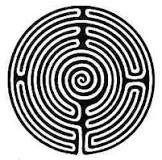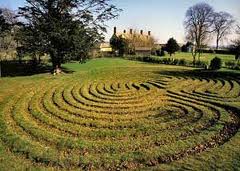Losing My Mind
I am at Pendle Hill, a Quaker retreat center outside Philadelphia. Like all retreat centers it is a refuge of quiet, a place of reflection, a deliberate exit from the fast lane of contemporary life. The buildings are Pennsylvania fieldstone, circa 1930, small, spare, rather cold (Quakers waste nothing, especially fuel oil), but with roaring fireplaces, thank God.
In a November still-green sward that slopes away from the retreat house, I am delighted to find a labyrinth cut into the tall grass. I have never seen a turf labyrinth, only stone designs in cathedral floors, or canvas replicas spread out in parish halls or chapels where people can have the experience of walking this apparent puzzle. This one is cut with a mower. The grasses and wildflowers, grown knee high over the summer, have relented at first frost and hang languidly along the path.
I step in. You must trust a labyrinth. It is not a maze. The Cretan Labyrinth, created by the ancient artificer, Daedalus, to imprison the half-man half-bull Minotaur at its center, was so confusing Daedalus himself barely escaped when he had finished building it. Daedulus’ creation is called a labyrinth, but it is actually a deliberate maze: intended to confuse and trap anyone who enters. (The only way Theseus is able to get to the center, kill the Minotaur, and thereby spare the children of Athens who would be fed to the beast, is by taking the skein of thread given him by Ariadne, which he ties to the door of the entrance, unwinds as he moves to the center and follows again on his return.)
A thousand years ago Christians took the ancient labyrinth and crafted a spiritual practice, designed to move a seeker through a winding path that weaves in and out—hooking inner and outer worlds—leading inevitably to a center. Unlike the classical labyrinths that had multiple routes, some of which dead-ended in confusion and lostness, the Christian labyrinths were “unicursal”—having one path. You could not get lost. The route would turn, curve back upon itself, lead you toward the center, then far away. But if you kept walking, kept trusting, you would reach the center.
It has been a long while since I walked a labyrinth. As I wend my way toward the center (where an old stump welcomes the pilgrim, who may sit and pray for a moment at the source of it all), I remember why Christians created these. The quintessential medieval labyrinth at Chartres Cathedral was laid out in the center aisle before the high altar. You couldn’t just walk into church and make a bee line for the holy of holies. You had to walk the labyrinth. You had to accept that the path to the sacred, to the numinous, was not linear. You had to let go of your calculating brain (figuring, among its thousand functions a minute, the shortest distance between two points), lay down your GPS mind. It would take God a few twists and turns to draw you into another realm.
If medieval people could sense that they were too driven, too controlling, too locked in one brain hemisphere; that the path to God was necessarily winding and switch-backed and all over the place; that the soul had to follow a path in which the ego-dominated mind would be lost; how much more must we?


I have certainly always adhered to the shortest distance between two points is a straight line rule. But lately I’ve found taking the circuitous route – a walk in the woods with my dog, the longer scenic route to my sister’s house in Pound Ridge, getting off MetroNorth and looking wondrously at the moon and the stars – has nourished my soul with the simple joys of life. My son and I were saying the other night that there just aren’t enough hours in the day or days in the week. I said to him “Well what would happen if we had 8 days in the week?” He responded, “We’d start pining for 9!” Pretty prophetic for a 12 year old.
“You can’t get lost.” At the center, at the end, of a circuitous uncertainty there is certainty. Thanks, David. I needed that.